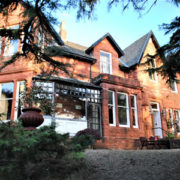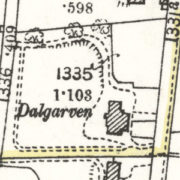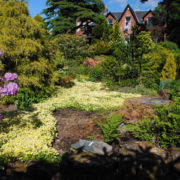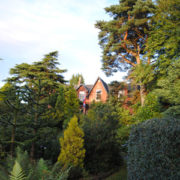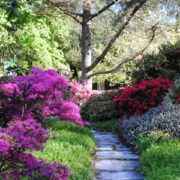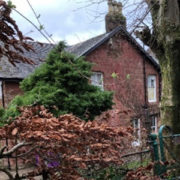29 The Lane, Skelmorlie
Source of photos: 1. Dalgarven from West – The Phillips family. 2. 1910 Ordinance Survey Map. Dalgarven sits between the Lane (left) and Seton Terrace(right). 3. & 4. Dalgarven from West/The Lane – The Phillips family 5. Gardens at Dalgarven – The Phillips family. 6. Dalgarven from the East/ Seton Terrace – ND Feb 2020.
| Owners | Alterations |
|---|---|
| William & James Goudie Builders | Dalgarven built |
| Mr Adam Primrose | |
| Mrs M Kirkwood & family | House altered and extended to North |
| Mr & Mrs John Murdoch Galbreath | |
| The Phillips family | 2008: Small plot of land to Northeast sold and a single dwelling subsequently constructed. |
Research:
- In December 1879, Archibald William Montgomery, Earl of Eglinton and Winton sold the land, upon which Dalgarven was subsequently built, to William and James Goudie Builders. It’s believed that the builders originated from Dalgarven Mill, near Dalry and the house name derives from this. The land amounting to just over 1 acre was subject to the requirement that two villas of value of not less than £500, each to be built on the land within 2 years. Only one house, Dalgarven, was constructed. There was also a requirement to enclose the whole area of ground with a stone wall. This wasn’t erected, instead, the property was contained by an iron fence, the remnants of which are still visible today. Source: The Phillips family, current owners of Dalgarven.
- From the records, it appears that a Mr Adam Primrose was the first owner of Dalgarven, however we’ve been unable to locate any information relating to when he bought the house or any details about him. Source: The Phillips family, current owners of Dalgarven.
- That said, we do know that in 1885, the Trustees of the late Adam Primrose sold the house to Mrs Margaret Ann (Hood) Kirkwood. Margaret Hood was born in Glasgow in 1844/5. In 1869, when she was 24, she married Richard Reid Kirkwood, West India Merchant, who was 30. At the time of the wedding, Margaret gave her usual residence as 8 Royal Terrace, Glasgow. Richard’s address is also Glasgow but the street name and number are indecipherable. Sources: The Phillips family & birth & marriage certificates for the Kirkwoods.
- There is no trace of the couple at the time of the 1871 census but in September 1879 Margaret gave birth to a baby girl, Mary Helen Kirkwood at home at 8 Royal Terrace, Glasgow. The family continued to live at Royal Terrace until at least 1891 when Richard died, thereafter Margaret and Mary moved to 4 Fitzroy Place, literally a stone’s throw away. Dalgarven was clearly bought by Margaret as a holiday home for the family and there must have been many cherished memories of the house, as Mary chose Dalgarven as the venue for her wedding to Leslie Johnston Paton, in April 1906. After Margaret’s death in 1913, the house became the property of Mary and her husband. By that time, they were living in Harley Street, London. Sources: 1871 & 1891 censuses and birth, death and marriage certificates for the Kirkwood family.
- Mary and Leslie Paton, held onto Dalgarven for the next 5 years, and then sold to John Murdoch Galbreath in 1918 for £1,400. It was around this time that Dalgarven was altered and extended to the north. Source: The Phillips family.
- Mr John Galbreath was born in 1881 to Murdoch Galbreath, Worsted Spinner and Mary (Whitelaw) Galbreath. In 1908, when he was a Mill Manager, he married Edith Anne (Carlyle) Galbreath, aged 23, daughter of John Carlyle, Dr of Medicine and Jane (Anderson) Carlyle, at West Parish Church, Greenock. Source: Birth and marriage certificates for the Galbreaths.
- We know that John and Edith had at least one child, Mary Anderson, who was born in February 1910 at their home in Finnart St, Greenock and would have been 8 years old when they moved to Skelmorlie. Source: Birth certificate for Mary Galbreath.
- Sadly, Edith died of Influenza in 1921 at home (Dalgarven) when she was only 36 and her daughter, Mary was only 11. Three years later John, then 43, married Edith’s younger sister (by two years), Alice Jane Carlyle, then 37. We understand that prior to the marriage, Alice was living at Skelmorlie House and this was one of the first such marriages following the Deceased Wife’s Sister’s Marriage Act of 1907. Source: Phillips family and marriage and death certificates.
- We are told that the Galbreaths employed two gardeners, two housemaids and a chauffeur and that the garden originally included a grass tennis court and croquet lawn. We understand that one of the gardeners was a Mr Ritchie and that his wife also worked in the house. The Ritchies were well known in the village and still have relatives in the community. Source: Phillips family.
- At the age of 76, John Galbreath, died at home. His death was registered by his brother George who lived at Invermay, Alice, continued to live at Dalgarven with her companion /housekeeper, Mary (could this be her niece/step daughter?), until 1975, when she sold the house and moved nearer to her family in Kilmacolm. Source: Phillips family and marriage and death certificates.
- At the time, the selling agents, described Dalgarven as follows: The house is set in an acre of ornamental gardens completely enclosed by mature trees. It is approached by a private driveway and is built of red sandstone with a slate roof of individual character and distinction. Inside, there is an impressive oak parquet floor in the hallway, a front reception lounge, a sitting room with a feature arch, walk-in bay windows and access to the veranda and garden. The dining room has leaded glass windows, Adam style wall decoration (panels and mouldings) and a marble fireplace with a walnut mantle piece and surround. Upstairs, there is a smoke room as well as four bedrooms. Source: The Phillips family.
- The new owners of Dalgarven were the Phillips family, who continue to own and live in the house today. Over the last 45 years, the family have undertaken significant work on the house, both in modernisation and maintenance. When they moved in, the old wash house was still in situ; as well as the mangle, deep double sinks and water boiler, there was also a cast iron bath which was used by the servants. Like many of the big houses, there were and still are, call bells throughout, connected to an indicator board in the kitchen, including one embedded in the floor in the dining room. Whilst the system now operates electrically, the remnants of the old wires and levers can still be seen in the loft. The bells still all work, but these days there is nobody to summon, other than family members! As keen gardeners, the Phillips family have also remodelled outside, creating a ‘tranquil haven of lawn and informal paths winding through mature shrubs such as camellias, azaleas and magnolias’ as shown in the pictures at the head of the page. Source: The Phillips family.
Note: Sub-Lieutenant Ian Brodie Galbreath of the Royal Naval Volunteer Reserve, who died on 23 December 1943, aged 20 and is remembered on the Skelmorlie and Wemyss Bay War Memorial, was a nephew of John and Edith/Alice Galbreath. Ian was the son of George and Margaret Galbreath, who moved to the village just before or at the start of WW2. See Invermay.

